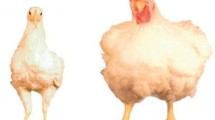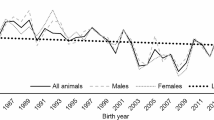Abstract
Sheep breeding is of great importance for the Tuva Republic. The sheep population exceeds 1.2 million heads. Surveys were carried out to find out the additional reserves for increasing lamb meat production. The typological structure was defined with the method based on the motor response to feeding, which was developed by D.K. Belyaev and V.N. Martynova (1973) and improved by V.S. Zarytovsky and M.I. Liev (1990). It provides the allocation of three behavioral types described as strong early maturing even-tempered, strong early maturing short-tempered, and weak late-maturing for the first, second, and third behavioral types, respectively. The ram lambs of group one were at definite advantages over the animals of groups two and three. Thus, increases in the carcass fresh weight, the slaughter weight, and the carcass yield comprised 0.92 and 1.85 kg (3.32 and 6.82%), 0.97 and 1.90 kg (3.58 and 7.00%), and 1.80 and 2.06%, respectively. The percentages of carcass meat and bone tissues varied within 69.61–69.96 and 16.46–17.36%, respectively. The rise in lamb population and the use of ram lambs of the first feeding behavioral type (strong early maturing even-tempered) contributed to increasing the potential of lamb meat production. The findings based on the complex survey results prove the dependency of traits of economic importance on the type of animal feeding behavior. Therefore, the survey findings supported by scientific knowledge can contribute to improving the indigenous short fat-tailed sheep of Tuva breed and to developing recommendations based on the feeding-behavioral type information.
Similar content being viewed by others
REFERENCES
Abilov, B.T., Intensive rearing of lambs increases the profitability of lamb production, Ovtsy, Kozy, Sherst. Delo, 2017, no. 3, p. 30.
Dvalishvili, V.G. and Opakai, Ch.M.O., Meat productivity of young meat and wool sheep of different origins, Ovtsy, Kozy, Sherst. Delo, 2018, no. 4, pp. 21–22.
Pompaev, P.M., The use of sheep of various genotypes in the production of young mutton in the Republic of Kalmykia, Vestn. Kalmytskogo Univ., 2012, no. 2, p. 26.
Karabaeva, M. and Kolotova, N., Meat productivity and meat quality of young sheep of different genotypes, Vet. S-kh. Zhivotn., 2017, no. 1, pp. 16–21.
Yuldashbaev, Yu.A., Salaev, B.K., and Garyaev, B.E., Productivity and biological characteristics of fat-tailed sheep of Kalmykia, Izv. Timiryazevsk. Akad., 2015, no. 5, pp. 106–123.
Koshelev, Yu.P., Eating behavior and productivity of young castrated rams of the Tsigai breed of sheep, Extended Abstract of Cand. Sci. (Agric.) Dissertation, Stavropol, 2000.
Pavlov, D.M., The relationship of the type of eating behavior with the wool and meat productivity of Tsigai young ewes, Extended Abstract of Cand. Sci. (Agric.) Dissertation, Saratov, 2002.
Khachirov, T.S., The productivity of sheep of the Soviet meat-wool breed, depending on the type of eating behavior and at different levels of feeding, Doctoral (Agric.) Dissertation, 2006.
Yuldashbayev, Y.A., Koshchaev, A.G., Inyukina, T.A., et al., Dependence of the physicochemical composition and biological value of the meat of Tuvanian short-fattailed sheep on the type of feeding behavior, Int. J. Eng. Adv. Technol., 2019, vol. 8, no. 6, pp. 5161–5166.
Kargayeva, M.T., Baimukanov, D.A., Karynbayev, A.K., et al., Productive-biological features of Aday breed Kazakh horses, Eurasian J. Biosci., 2020, vol. 14, no. 1, pp. 329–335.
Shamshidin, A.S., Kharzhau, A., Baimukanov, D.A., et al., Molecular genetic profile of Kazakhstan populations of cattle breeds, Bull. Natl. Acad. Sci. Rep. Kaz., 2019, vol. 6, no. 382, pp. 154–162. https://doi.org/10.32014/2019.2518-1467.157
Belyaev, D.K. and Martynova, V.N., USSR Inventor’s Certificate no. SU1442156, Byull. Izobret., 1988, no. 45.
Author information
Authors and Affiliations
Corresponding author
Ethics declarations
Conflict of interests. The authors declare that they have no conflicts of interest.
Statement on the welfare of animals. All applicable international, national, and/or institutional guidelines for the care and use of animals were followed.
Additional information
Translated by O. Zhiryakova
About this article
Cite this article
Yuldashbaev, Y.A., Chylbak-ool, S.O., Erokhin, A.I. et al. Impact of Feeding Behavior on Biological and Productive Properties of Tuva Ram Lambs. Russ. Agricult. Sci. 47, 304–309 (2021). https://doi.org/10.3103/S1068367421030204
Received:
Revised:
Accepted:
Published:
Issue Date:
DOI: https://doi.org/10.3103/S1068367421030204




